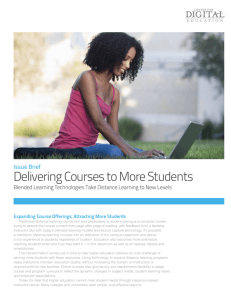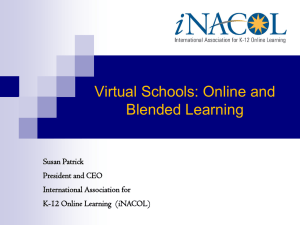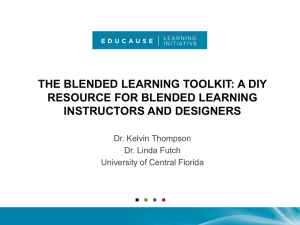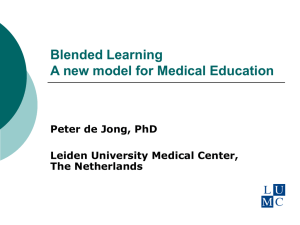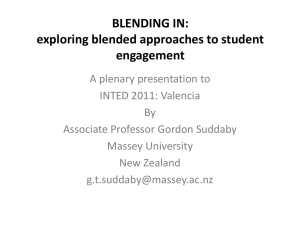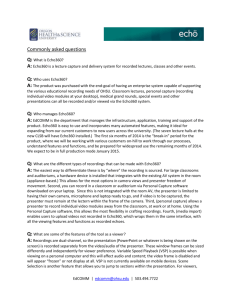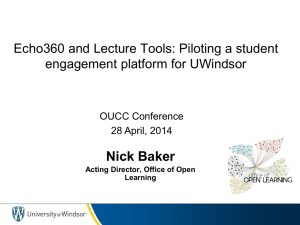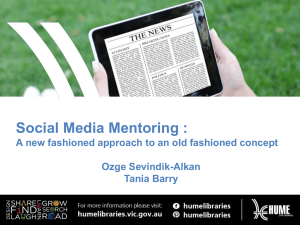The Four Pillars of Blended Learning
advertisement
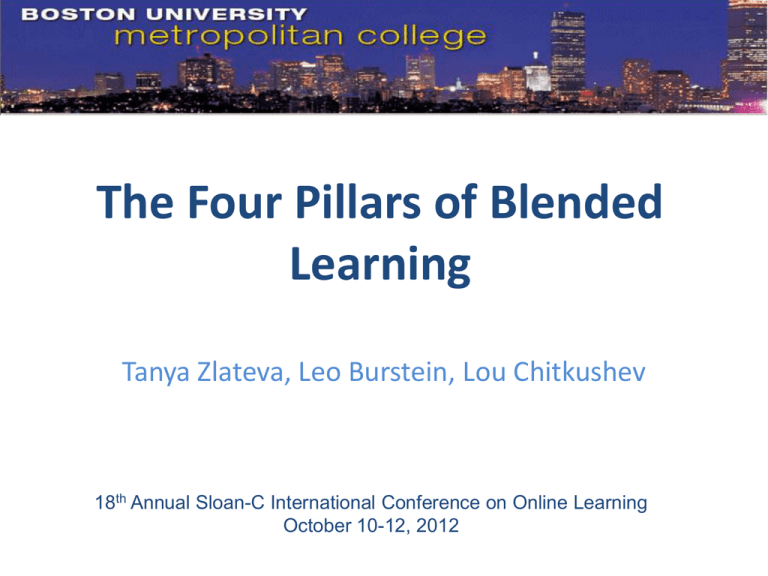
The Four Pillars of Blended Learning Tanya Zlateva, Leo Burstein, Lou Chitkushev 18th Annual Sloan-C International Conference on Online Learning October 10-12, 2012 The Four Pillars of Blended Learning October 2012 © 2012 Boston University 2 The Promise of Blended Learning Success Learning environment Start • Mixing X% online and Y% face-to-face learning? • Bringing together the best from traditional on-campus and distance education models (why?) • To create an environment that helps students to achieve learning objectives by choosing a path that best fits their learning preferences and life/work circumstances. 3 Getting It Done: The Basics The answer is an area and depends on student’s independent learning ability DE Structure Course materials, well defined activities, schedules, etc. F2F 0 Moore’s TD Theory Dialog Maintain optimal “transactional distance” using both structure (LMS-supported) and dialog (both async and sync communications). f2f sessions, online discussions, video collaboration 4 1. Structure Structure is a critical component of blended learning. By choosing a blended course format students are essentially asking for help in balancing their educational objectives with commitments outside of the university campus. An advance course management system, together with a welldesigned network of student and faculty support services, bring a solid structure into the learning process and becomes a critical factor in achieving systematic progress and high performance levels. The system provides a single point of access to organized course materials, learning activities, calendar, communication tools, grade information, etc. 5 2. Collaboration Ubiquitous, time and space transcending access to course materials and activities create an “always-on” atmosphere, strengthens the learning community, and enables students to define their personal blend of in person and online attendance and self-study while maintaining academic rigor and discipline. We see that even students who are strong self-learners appreciate the opportunities to meet in person with faculty and classmates and establish strong and lasting relationships. Multimodal delivery allows all students to become part of communities built around their academic and professional interests. 6 3. Self-Study All courses include built-in independent learning elements, supported by asynchronous communications through recorded lectures and seminars, pre-recorded tutorials, and just-in-time faculty commentary, for example, an analysis of latest course-related events or student performance feedback. 7 “I specifically took this class because of the format. I knew I was going to have an unpredictable schedule this spring” “The blended format is great and is so convenient for working professionals. Please keep offering blended format courses.” “Overall great format and would recommend the course in its blended format to others.” “Everything is perfect for me now in this class.” Distance v← v “The online video and recording are great.” Four face-to-face classroom sessions.... 1. Were sufficient 2. Were too few 3. Were too many 50% 45% 5% “Its the best of both, having the ability to have a fully functional online course and get to meet the professor” Student Feedback “I like the fact that the course is spread out and was able to take time in my busy schedule. Also the interaction with the instructor was a tremendous help.” For me, this material is not intuitive and I would prefer to take this class in a face to face environment. v On-campus → “Well it definitely solved the time constraint problem for me after doing full time job. I like the blended session but at the same time I wish it could have had 2 more classroom sessions.” “I enjoyed the ability to meet the instructor in person. I think that forms a better relationship between student and instructor.” 8 Information Age Realities Workplace Education Teach how to fish Fish Teach how to learn to fish Practical skills and business competencies are more important than ever 9 The Student Perspective Academic Foundation Student View what students need to succeed 10 4. Student Success and Motivation Fusion of academic knowledge, practical skills and workplace competencies is one of the design objectives that increases student engagement and helps them to faster realize educational benefits through career advancement, new employment opportunities and increased personal satisfaction. The latest virtualization technologies create opportunities to bring more case studies and real-world scenarios into educational process, and practicing “see the whole picture” concepts to overcome the risks of developing a fragmented vision due to sequential module-based teaching. 11 Embracing Technological Innovations Structure: organized content & activities (CMS/ID) Dialog: Keep students engaged, maintain a learning energy conduit, transcend distance and time with “eLive Classroom” – a combination of synchronous and asynchronous capabilities: } 1. Video collaboration (distance) 2. Classroom and personal multimedia recording (time) 3. Virtual laboratories for real practical learning (tech) 12 Operating Principles Promote self-reliance: provide intuitive, appliance-like ubiquitous solutions; give faculty greater control and ongoing access to course content and communications. Keep costs down: students helping students, welldefined internal processes, open source, optimized technical architecture, leverage existing services, disciplined research and “greenhouse” adoption. Support technologies with services: protect faculty and students from struggling with emerging technologies. 13 The Four Pillars of Blended Learning Questions and Answers October 2012 © 2012 Boston University Metropolitan College 14 SUPPLEMENTAL MATERIAL The King is Dead. Long Live the King! Online banking and “blended” banks? What is “flexibility”? Our “blended” future 16 Getting It Done: Instruments for Building an Effective Blended Program The answer is an area and depends on student’s independent learning ability DE Structure Course materials, well defined activities, schedules, etc. F2F 0 Moore’s TD Theory Dialog Maintain optimal “transactional distance” using both structure (CMS-supported) and dialog (both async and sync communications). f2f sessions, online discussions, video collaboration 17 Video Collaboration Options Exceeding Comparability: 1 - Empower Faculty We work with faculty to enhance the variety of teaching approaches Assist with program design for multi-modal delivery Provide tools and assistance for developing rich multimedia content Manage course logistics Create a sense of community for you and your students 20 Exceeding Comparability: 2 - Broaden the Audience We help you to increase student quality and diversity by breaking traditional residency barriers and meeting the highest student expectations: Flexibility and choice (accommodate different lifestyles and personal preferences) Updated facilities and support for new communication patterns (welcome “digital natives”) Focus on developing practical skills and workplace competencies to supplement academic knowledge and ensure long-term student success. 21 The Rise of Blended Learning MET identified blended learning as a strategic priority for future growth in order to protect and enhance our enrollments, and to create a practical option to extend our reach and pursue specific opportunities, both regional and international. eLive: •Represents a pre-determined balance of some classroom and continuous online education •Improves the quality of teaching through ongoing engagement and interaction •Promotes student success by focusing on active learning that is immediately applicable to professional skills and everyday life. 23 Recording and Delivery • Full/partial lectures recorded in real time: – In a classroom setting – Online lectures and meetings • Tutorials, homework reviews, etc. recorded offline • Automation of encoding/publishing is a key • Choice of technologies and cost controls (see next slide) 24 Effort Know-how Innovation and Adoption Strategies (The Dichotomy of Passion) Time Complex tools require longer and/or multiple training sessions. At the same, skills will be lost if not routinely used. 25 Know-how Innovation and Adoption Strategies (The Dichotomy of Passion) Pareto (80/20) Principle Effort 20% Time Strategy 1: Reduce learning curve by focusing on essential functionality (80%) 26 Know-how Innovation and Adoption Strategies (The Dichotomy of Passion) Service Effort 20% Time Strategy 2: Reduce learning curve by extending service levels (SLA) 27 Blended Design and Delivery • Examine and discuss best pedagogical practices for blending face-to-face and online learning • Discover how you can help your students rewind, relive, and reconnect with the classroom experience • Discover how to maintain community and continuity outside of the classroom 28 Mixing it Up • Analyze Course Objectives – Break down into learning objects • Determine the Best Delivery Approach – Online, in the classroom, or both • Build the Course – Logical grouping of material – Consider delivery method 29 Considerations • • • • • • • • • Missed Class English Proficiency Challenges Prerequisite Material Challenging Topics Advanced Content Cross-course Content Faculty Time Constraints Office hours, One-on-One Time Collaborative Work 30 Lecture Capture with Echo360 1. Audio Capture 2. Video Capture 3. Screen Capture 31 32 Synchronous Sessions • One-to-many; facilitated – Online Lectures – Office Hours – Small Group Activities – Student Presentations • Tools: – MET-Meet – Wimba Live Classroom 33 Asynchronous Sessions • One-to-many – Online lectures – Tutorials – Student Presentations • Tools: – Echo360 – Camtasia Relay – Camtasia •Echo360 • Missed Class Solutions •Echo360, • EnglishCamtasia Proficiency Challenges • Prerequisite Material •Echo360, Camtasia • Challenging Topics •Echo360, Camtasia, MET-Meet, Live Classroom •• Echo360, Advanced Content Camtasia •• Echo360, Cross-course Content Camtasia •• Echo360, Faculty Time Constraints Camtasia, MET-Meet, Live Classroom •• MET-Meet Office hours, One-on-One Time •• MET-Meet Collaborative Work 35 Summary • Blended learning takes advantage of online technologies, but simple use of online technologies does not make a course blended • Blended learning describes instruction in terms of outcomes – and not the number of hours a student spends each week in classes, labs and seminars. • Blended programs assume a commitment to maintain course structure throughout the program. 36
